The lower story and the arch are very old (12th century). The upper stories were rebuilt after the rebellion against Henry Tudor in 1489-90 and the siege during the English civil war (1644) when the Parliamentarians blasted the bar with five cannons set up on a nearby hill. Behind the arch is the only remaining barbican, defensive walls surrounding the entrance (see pictures below).
Some notes from the underground: The barbican sags as its foundation was compromised by tunnels as the parliamentarians attempted to burrow their way into the city during the civil war to plant explosives. Fortunately, the town defenders heard about the plot from a captured prisoner (was intelligence better then?). Consequently, they dug a tunnel from the inside of the walls outward to deactivate the threat.
The white wooden extension rests on two pillars and was incongruously added near the end of the 16th century to improve the lodging of the bartender. It was a residence until 1960 when it became the first Barbican bookshop.
Full pictures of the 14th century barbican are in short supply, but you may see one by clicking here.

Lost? If so, click here for a good map of the York Walls (in PDF format)
Here's two pictures of the outer wall of the Walmgate Barbican taken through the left and right arches:
Another full (but small) picture of the only remaining York barbican, click here.
Lost? If so, click here for a good map of the York Walls (in PDF format)
For more narrative on York, see our description web page by clicking here.
|
|
Send us email (it's safe to enable JavaScript on this page) |